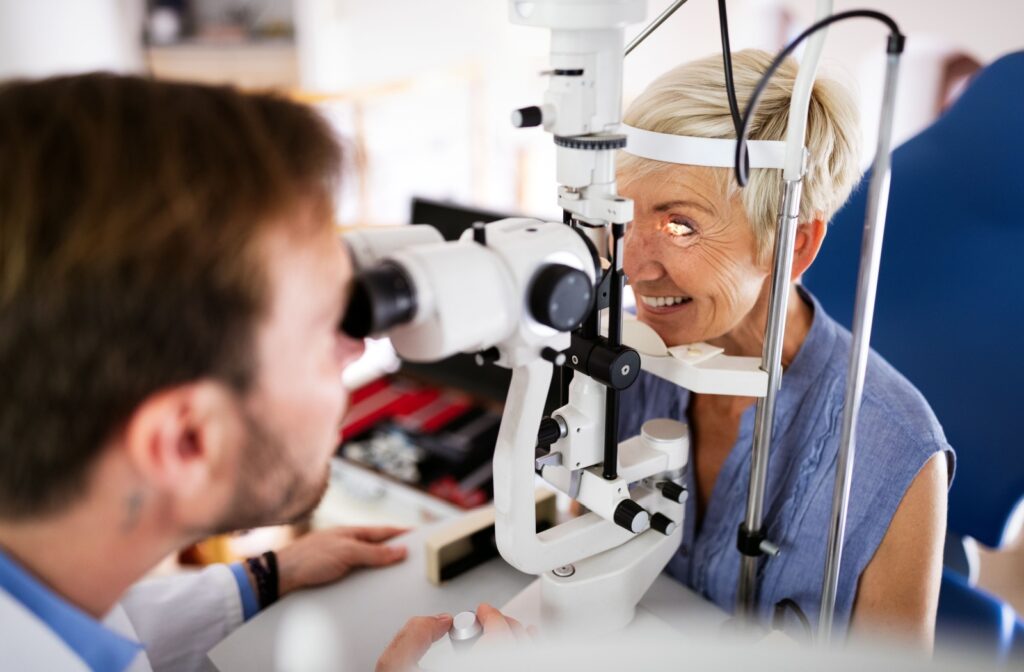Dry eye syndrome affects millions of people worldwide, causing discomfort and impacting quality of life. The meibomian glands, tiny oil-producing glands located in the eyelids, play a crucial role in maintaining eye health by secreting oils that prevent the evaporation of the eye’s tear film.
However, when these glands become blocked or dysfunctional, it can lead to meibomian gland dysfunction (MGD), a leading cause of dry eye syndrome. When other treatments are unable to provide relief from dry eye syndrome’s irritation symptoms, we may recommend intraductal meibomian gland probing.
Meibomian gland probing (MGP) is a procedure where a tiny probe is gently inserted into the blocked meibomian glands to clear obstructions and restore the normal flow of oils essential for a healthy tear film.
Understanding Meibomian Gland Dysfunction
Meibomian gland dysfunction (MGD) occurs when the meibomian glands that line your eyelids fail to secrete oils properly, leading to evaporative dry eye. Common symptoms include:
- Irritation and redness
- A gritty or sandy sensation
- Blurred vision
- Sensitivity to light
- Excessive tearing
MGD is rarely due to a single factor, and it can build up over time. Some common causes behind MGD are:
- Aging
- Hormonal changes
- Medication side effects
- Contact lens use
- Environmental conditions like pollution
- Eyelash mites
- Blepharitis
Any of these conditions can cause bacteria to build up within the glands that require precise treatments to clear. However, in some cases, nonvisible scarring can occur around the gland ducts, blocking the flow of oil. It’s this problem that meibomian gland probing seeks to solve.
The Science Behind Meibomian Gland Probing (MGP)
Meibomian gland probing (MGP) is used to treat severe cases of MGD. It aims to relieve constricting scar tissue surrounding the meibomian glands. When scar tissue forms around the meibomian glands, it compresses them and prevents the release of meibum. Think of this tissue like a rubber band. Just as a rubber band can construct around a tube and prevent the contents from leaving, scar tissue compresses the meibomian glands, creating internal blockages that must be relieved for effective treatment.
During MGP, we gently insert specialized Maskin probes into the meibomian glands, breaking up these scar tissue blockages. This allows the meibum to flow freely, promoting natural tear production, eye moisture, and health.
The MGP Process
Before proceeding with MGP, we will need to diagnose the presence and extent of dry eye syndrome. Diagnostic tests may include measuring:
- Tear break-up time: This test assesses the stability of your tear film by measuring how quickly your tears evaporate. We’ll put a small amount of dye in your and ask you to blink to spread the dye evenly. We can then watch to see how long it takes for the dyed tears to break up.
- Tear osmolarity tests: Tear osmolarity tests measure the salt concentration in your tear film, providing insights into their water quality. Too much or too little salt in your tears can indicate dry eye.
By combining the results of these diagnostic tools, we can better understand your dry eye syndrome and tailor the treatment plan to your specific needs. If we recommend MGP, here’s what you can expect during the procedure:
- Preparation: We’ll begin by applying numbing ointment to the eyelid and have you wear a bandage contact lens. It can take about 10 minutes for the anesthetic to take effect, and this is all done to help you feel comfortable during the procedure.
- Probing: Once you’re comfortable, we’ll use a 1mm probe to gently relieve obstructions from each meibomian gland. You might hear or feel a popping sound, which indicates the release of blockage and scar tissue breakup.
- Further treatment: If necessary, we may use longer probes to address deeper scarring.
- Clean up & gland expression: We can then remove the bandage contact, clean the eye, and wipe away any remaining numbing ointment. We may follow up with some gland expression to clear away the last of the blockages.
After the procedure, we may prescribe lubricating eye drops or ointments to aid in healing and schedule follow-up appointments to monitor your progress and ensure the glands remain open.
Discover Relief Through Meibomian Gland Probing
Meibomian gland probing is a promising treatment for those suffering from severe dry eye due to MGD. By relieving constricting scar tissue and restoring the natural flow of meibum, MGP not only alleviates dry eye symptoms but can also enhance the effectiveness of other treatments such as warm compresses, eyelid hygiene, and medications.
If you’re experiencing persistent dry eye symptoms, don’t wait. Book an appointment with Higgins Brothers’ Vision Care today to explore if meibomian gland probing is right for you. Feel free to reach out if you have any questions or need further information. Your eye health is our priority, and we’re here to help you every step of the way!




